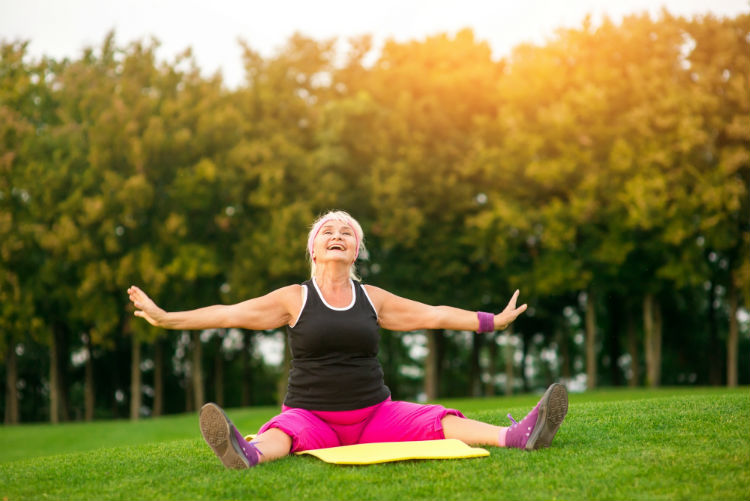Breathing is something we do without thinking, so it is easy to take it for granted. But as people age, they are more likely to develop respiratory complications and experience breathing difficulties. Along with this inability to breathe freely and sustain healthy blood oxygen levels comes a host of other ailments, including elevated anxiety and emotional stress, reduced energy levels, and compromised immune function.
Measuring Oxygen Saturation Levels
A pulse oximeter is a small device that easily and non-invasively can detect how efficiently oxygen is carried from the heart to the finger (or toe) that the device is clipped to. Pulse oximeters measure oxygen saturation level. According to the American Thoracic Society, most people need an oxygen saturation level of at least 89 percent.
Awareness of oxygen saturation levels and use of pulse oximeters has become more common due to Covid-19’s impact on blood oxygen levels. For older adults who are dealing with illnesses such as COPD, pneumonia and heart disease, it is important to consistently monitor the flow of oxygen from the heart throughout the body. A pulse oximeter reading can quickly and easily indicate heart rate and oxygen saturation to inform a doctor or caregiver of whether a treatment is effective, a medication is working or if there is need for supplemental oxygen.
The good news is there are some natural methods of increasing your blood oxygen level. Everyone can benefit from the improved concentration, healing and sleep that a higher level of oxygen provides. Caregivers can help their aging loved ones alleviate troubling symptoms of chronic illness and improve their overall health through focused breathing exercises that increase oxygen saturation in the body and ease physical and mental stress.
Benefits of Breathing Exercises
Pulmonary rehabilitation is an important intervention for individuals with lung disease or other conditions that affect lung function. Respiratory therapists frequently teach their patients specialized breathing techniques, which can alleviate some of the symptoms associated with asthma attacks, high blood pressure, shortness of breath, chronic obstructive pulmonary disease (COPD) and sleep apnea. According to the American Lung Association, “If practiced regularly, breathing exercises can help rid the lungs of accumulated stale air, increase oxygen levels and get the diaphragm to return to its job of helping you breathe.”
The benefits do not stop there, though. Even healthy individuals can experience the calming and rejuvenating effects of controlled breathing. In fact, breathing exercises can help improve overall respiratory health and lung capacity. Seniors and their caregivers can practice these techniques together to reap the benefits.
Types of Breathing Techniques
Try the three exercises below to find one that is most useful for each of you.
Diaphragmatic Breathing
Believe it or not, there is a right way to breathe, but most people don’t practice it. Patients with limited lung capacity often fall into the habit of taking short, shallow breaths into their chest. If a person’s chest rises as they take a breath, it is a likely indicator of improper breathing. A proper breath will draw air into the lungs, pushing the diaphragm down and visibly expanding the belly. This is why diaphragmatic breathing is also called “belly breathing.” Follow these steps to engage in deep, diaphragmatic breathing:
- Sit up straight, with one hand on the stomach and the other on the chest.
- Inhale slowly and deeply through the nostrils, feeling the stomach expand with each full, diaphragmatic breath.
- Exhale slowly out of the mouth.
- Repeat six or more times each minute for up to 15 minutes.
4-7-8 Breathing
The popular 4-7-8 breathing method has been touted as one of the most effective (and speedy) ways to fall asleep. Anecdotal evidence suggests that a person can drift off in less than a minute using this approach. Part of the 4-7-8 technique’s success lies in its ability to ease tension and promote relaxation. Practicing the following focused breathing exercise twice a day will help reduce stress and anxiety, which may provide relief from insomnia, mood swings and food cravings.
- Breathe out fully through the mouth, creating a wind-like “whoosh” noise.
- Keeping the mouth closed, inhale through the nose and silently count to four.
- Hold this breath while counting to seven.
- Exhale through the mouth for a count of eight, repeating the “whoosh” sound.
- Repeat steps two through four five times.
Buteyko Nose Breathing
Buteyko breathing was invented by Ukranian scientist Konstantin Pavlovich Buteyko in the 1950s to curb asthma attacks and treat other respiratory problems. At that time, the medical community resisted a breathing technique that could ease physical symptoms without the help of medication and other traditional interventions. Since then, people around the world have embraced Buteyko breathing specifically because it is natural and very effective.
Thousands have reported relief from asthma, sleep apnea and hypertension by integrating this proven method, which balances the body’s oxygen and carbon dioxide levels, into their daily routines. As a note, it is best to have senior patients initially perform this exercise under supervision to avoid improper technique that can result in hyperventilation.
- In a quiet, comfortable place, sit up straight and focus on breathing.
- Keeping the mouth closed, inhale slowly through the nostrils to fill the lungs.
- Exhale through the nostrils, slowly expelling air from the lungs, until you feel compelled to inhale.
- Repeat steps two and three five times.
Practice Breathing Exercises Daily
When patients begin using daily breathing techniques and notice positive results, they often stick with the program. Missing a day or two is acceptable, unless it affects a person’s whole routine and causes them to slip back into old, shallow breathing habits. Tracking progress with a diary can help you stick to your routine, recognize improvements and note any significant changes in your health.
We breathe more than 25,000 times each day, so it is easy to get lazy when it comes to this largely involuntary process. Using these breathing exercises, seniors and caregivers alike can shake old habits and develop new ones that lead to improved physical health and a renewed sense of mental alertness and clarity in only a few weeks.

